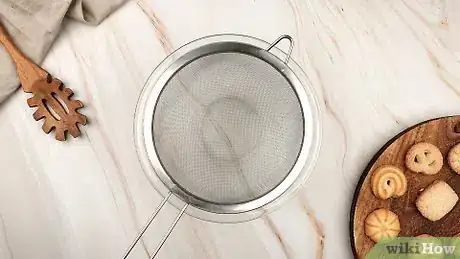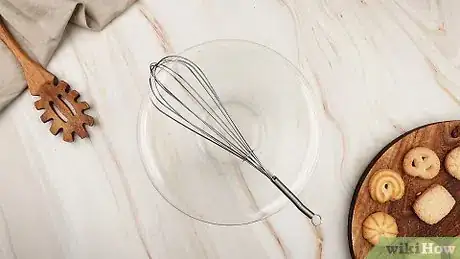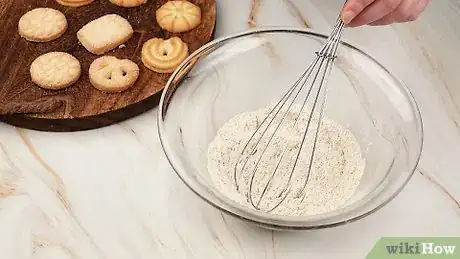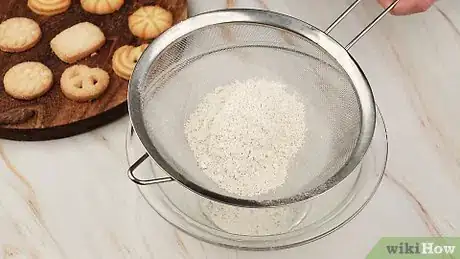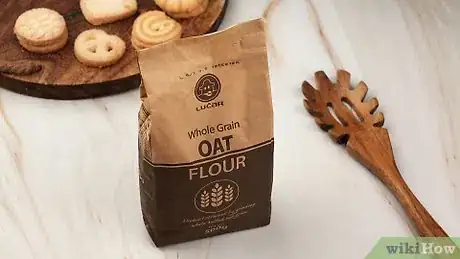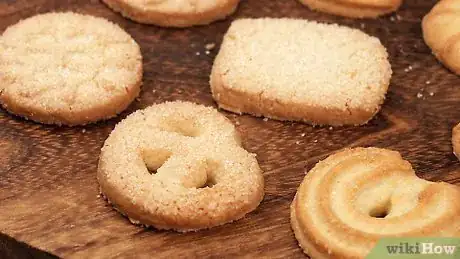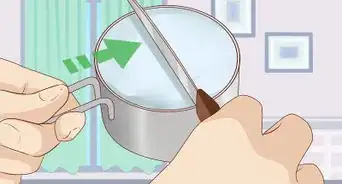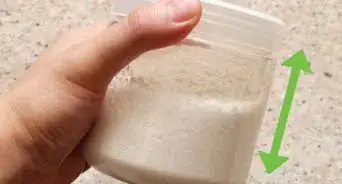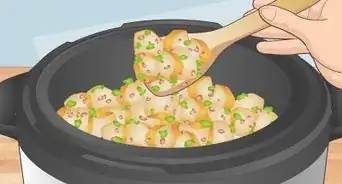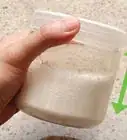This article was co-authored by JoAnna Minneci. JoAnna Minneci is a Professional Chef based in the Nashville, Tennessee area. With more than 18 years of experience, Chef JoAnna specializes in teaching others how to cook through private cooking lessons, team-building events, and wellness and nutrition classes. She has also appeared in numerous television shows on networks such as Bravo and Food Network. Chef JoAnna received Culinary Arts training from the Art Institute of California at Los Angeles. She is also certified in sanitation, nutrition, kitchen management, and cost control.
wikiHow marks an article as reader-approved once it receives enough positive feedback. In this case, several readers have written to tell us that this article was helpful to them, earning it our reader-approved status.
This article has been viewed 647,684 times.
Sifting flour helps aerate the flour, which allows it to mix more evenly into batter in certain recipes.[1] Many recipes call for sifted flour, but you may not have a flour sifter on hand. A flour sifter, while handy, is largely unnecessary when it comes to sifting flour. You can use a strainer or a wire whisk. If you do not have either, you can sift the flour with a fork. Sometimes, people skip the sifting step if they're in a rush. In some cases, this can be fine, but sometimes sifting flour is important. Recipes that require a delicate texture, for example, should include sifted flour.
Steps
Using a Strainer
-
1
-
2Pour the flour into the strainer. Take the strainer with one hand as you pour. Make sure to position the strainer just over the bowl you're using to collect the flour.[4]
- Flour is a powdery substance, so it can be a bit messy. Make sure to pour slowly. If you pour too fast, the flour may get on your shirt and your work surface.
- It's a good idea to wear an old shirt or an apron when sifting flour.
Advertisement -
3Tap the side of the strainer until all the flour falls into the bowl. Be gentle as you tap. You should tap with one hand, and hold the strainer with the other. Your tapping should cause flour to lightly sprinkle out of the strainer and into the bowl. The flour should be thinner and lump free as it falls into the bowl.[5]
- If the flour still has lumps in it when it falls in the bowl, you're tapping too hard. Put the flour back in the strainer and start over.
- It may take awhile to get all the flour through the strainer, so have patience. Do not tap the strainer hard to speed up the process. If the flour goes through the strainer too fast, it may not be sifted thoroughly enough.
Sifting Flour with a Fork or Wire Whisk
-
1Gather your supplies. If you don't have a strainer or sifter, you can use a wire whisk to sift the flour. In addition to a wire whisk, get a bowl large enough to contain as much flour as you need.[6]
- If you don't have a wire whisk, you can use a fork in a pinch. Go for a bigger fork, as this will allow you to sift the flour more efficiently.
-
2Stir the flour in circular motions using a fork or wire whisk. Place the correct amount of flour in your bowl. Take your wire whisk or fork and place it in the flour. Swirl the whisk or fork in quick, circular motions. You should start to see the flour even out and lose some lumps and hard spots.[7]
- If the flour is not evening out or losing lumps, you may need to use faster motions.
-
3Have patience when stirring your flour. It can take awhile to sift flour using this method, especially if you're sifting a large amount of flour. Try not to get frustrated. Keep working at the flour, swirling your whisk or fork in quick circular motions, until the flour is light and even throughout.[8]
- When you're finished, your flour should be lump free. You should be left with a light, even, and powdery substance.
- If your wrist gets sore, it's okay to take a break from sifting for a moment.
Figuring Out When You Need to Sift Flour
-
1Figure out when to sift your flour. Pay attention to the wording in the recipe when sifting your flour. The wording in a recipe affects how the flour is sifted. There is a difference between "1 cup flour, sifted" and "1 cup sifted flour."[9]
- If the recipe calls for "1 cup flour, sifted," measure the flour first. Then, transfer it to a bowl and sift.
- If the recipe calls for "1 cup sifted flour," sift a good portion of flour. Then, measure out however much you need for the recipe.
-
2Sift flour that has been sitting in a bag for a while. You do not always need to sift flour. If flour has not been sitting in a bag too long, it may be light enough to simply use in a recipe. When flour is in a bag for a long time, it begins to clump together, therefore requiring to be sifted, to break up the clumps.[10]
- If your bag of flour was squeezed into a cabinet, or had another item sitting on top of it, it's especially important to sift your flour.
-
3Make sure to sift flour for recipes with delicate textures. If your flour is not tightly compact, you may be able to skip the sifting process for some recipes. However, if you're making something that is meant to have a delicate texture, always sift your flour first. Recipes like angel food cake, for example, will require sifted flour.[11]
-
4Sift flour over a work surface before you roll or knead dough. If you're going to roll out dough, or knead it, flour can help prevent the dough from sticking to a work surface. Sifted flour generally works better in this case, as it will have less clumps and spread more evenly.[12]
- You should also sift flour if you're dusting flour over wax paper to roll out dough for sugar cookies.
Expert Q&A
-
QuestionIs a colander the same as a sifter?
 JoAnna MinneciJoAnna Minneci is a Professional Chef based in the Nashville, Tennessee area. With more than 18 years of experience, Chef JoAnna specializes in teaching others how to cook through private cooking lessons, team-building events, and wellness and nutrition classes. She has also appeared in numerous television shows on networks such as Bravo and Food Network. Chef JoAnna received Culinary Arts training from the Art Institute of California at Los Angeles. She is also certified in sanitation, nutrition, kitchen management, and cost control.
JoAnna MinneciJoAnna Minneci is a Professional Chef based in the Nashville, Tennessee area. With more than 18 years of experience, Chef JoAnna specializes in teaching others how to cook through private cooking lessons, team-building events, and wellness and nutrition classes. She has also appeared in numerous television shows on networks such as Bravo and Food Network. Chef JoAnna received Culinary Arts training from the Art Institute of California at Los Angeles. She is also certified in sanitation, nutrition, kitchen management, and cost control.
Professional Chef Nope—they're two different tools. Still, in the worst case scenario you can use a colander and a metal spoon to get some really large lumps out of your flour.
Nope—they're two different tools. Still, in the worst case scenario you can use a colander and a metal spoon to get some really large lumps out of your flour. -
QuestionWhich types of flour are especially important to sift?
 The Hungry BitesCommunity AnswerSifting isn't about the type of flour, but rather the texture of the goods you're making. If you're making stiff doughs like bread or pasta, then sifting isn't necessary because the dough is kneaded anyway. If you're making a softer dough, sifting can help aerate the flour, resulting in a fluffier product.
The Hungry BitesCommunity AnswerSifting isn't about the type of flour, but rather the texture of the goods you're making. If you're making stiff doughs like bread or pasta, then sifting isn't necessary because the dough is kneaded anyway. If you're making a softer dough, sifting can help aerate the flour, resulting in a fluffier product. -
QuestionCookie seems heavy and dense. I didn't sift with cocoa powder; is this why?
 Community AnswerI wouldn't think unsifted flour would be the only reason cookies are dense and heavy, unless you can actually see large lumps of flour. It could also be the ingredients weren't mixed well, which isn't always easy with most cookie doughs, as they can be pretty dense on their own! I'd suggest sifting the flour next time, gently but thoroughly mix all the ingredients together, and follow the cooking times/temps on the recipe.
Community AnswerI wouldn't think unsifted flour would be the only reason cookies are dense and heavy, unless you can actually see large lumps of flour. It could also be the ingredients weren't mixed well, which isn't always easy with most cookie doughs, as they can be pretty dense on their own! I'd suggest sifting the flour next time, gently but thoroughly mix all the ingredients together, and follow the cooking times/temps on the recipe.
References
- ↑ http://www.myrecipes.com/how-to/cooking-questions/sift-flour-for-cakes
- ↑ JoAnna Minneci. Professional Chef. Expert Interview. 23 December 2021.
- ↑ http://www.myrecipes.com/how-to/cooking-questions/sift-flour-for-cakes
- ↑ http://www.myrecipes.com/how-to/cooking-questions/sift-flour-for-cakes
- ↑ http://www.myrecipes.com/how-to/cooking-questions/sift-flour-for-cakes
- ↑ http://www.myrecipes.com/how-to/cooking-questions/sift-flour-for-cakes
- ↑ http://www.myrecipes.com/how-to/cooking-questions/sift-flour-for-cakes
- ↑ https://www.thekitchn.com/basic-techniques-how-to-sift-f-113062
- ↑ http://www.myrecipes.com/how-to/cooking-questions/sift-flour-for-cakes
- ↑ http://joythebaker.com/2013/09/baking-101-must-we-sift-this-flour/
- ↑ https://www.thekitchn.com/is-sifting-flour-for-baked-goods-really-necessary-213894
- ↑ https://www.thekitchn.com/is-sifting-flour-for-baked-goods-really-necessary-213894
- ↑ http://joythebaker.com/2013/09/baking-101-must-we-sift-this-flour/
About This Article
To sift flour with a strainer, hold the strainer over a bowl that’s slightly larger than the strainer and slowly pour in your flour. As you’re pouring, tap the side of the strainer gently against the side of the bowl so the flour goes through the strainer and into your bowl. If you don't have a strainer, you can use a fork or wire whisk to “sift” your flour. Put your flour in a bowl, then stir it using quick, circular motions with your fork or whisk. Keep stirring until your flour is light, even, and powdery. To learn how to figure out when and why you need sift your flour, keep reading!
